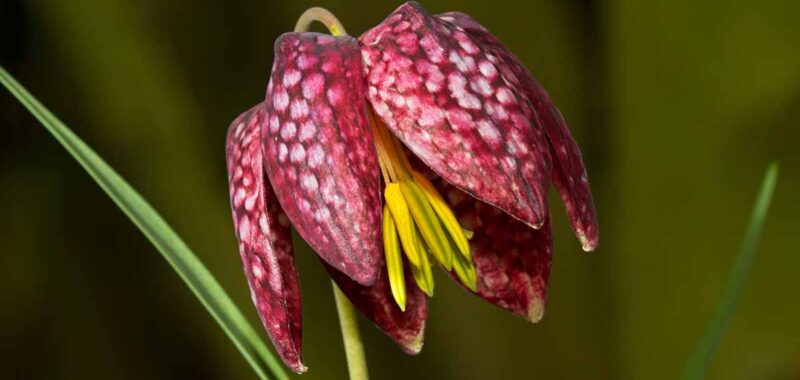The fritillarias, by and large, are very low maintenance. Hardy in USDA Zones 4 to 9, they can withstand all but the coldest of weather and are relatively pest free.
Light
Generally it’s best to situate fritillaria plants in full sun, but they will tolerate a bit of partial, dappled shade.
Soil
Fritillaria bulbs typically prefer rich loamy soils with a pH of 6.0 to 7.0 that are neither soggy nor dry, but research the specific needs of your chosen species.


Plant in freely draining, rich soils, filling planting holes with compost or grit, if you need to improve drainage.
If you aren’t sure your soil is organically-rich, it never hurts to throw in a few shovelfuls of compost when you plant.
Water
These bulbs are pretty tough when established, but for best results, water well during dry periods, or when the soil is dry to an inch down.


Ideally keep the soil evenly moist, with the texture of a well-wrung-out sponge.
Avoid growing fritillarias in areas that tend to be boggy, or the bulbs will rot.
Fertilizing
To keep your fritillaries well fed, especially the larger species, which are more demanding than the smaller ones, fertilize them each spring before they flower.
A good all-purpose fertilizer formulated for vegetables will do the trick, like Down to Earth’s All-Purpose Mix, with an NPK ratio of 4-6-2.


Down to Earth All-Purpose Mix
You can find Down to Earth All-Purpose Mix available at Arbico Organics.
Fall is the perfect time to divide mature Fritillaria plants, though you won’t have to do this often. Every few years is more than adequate.
You can read more about dividing in the Propagation section below.
Species to Select
As mentioned, there is an abundance of diversity within the beautiful Fritillaria genus. Below are just a few of the species I love best:
Affinis
The chocolate or checker lily, F. affinis, is a North American native. This delightful little plant produces brownish-purple flowers mottled with greenish, brownish, and purple spots.


The flowers may be single or borne in clusters on stems up to 48 inches tall.
Hardy in Zones 7 to 9, these plants grow wild in sites with very well draining soils across western North America.
Imperialis
Remarkable for its size, F. imperialis or crown imperial fritillary, is one of most recognizable species in the genus.
Producing a ring of bright orange, bell-shaped flowers reminiscent of lilies, this is an excellent choice for a flower border or pot.
This species is native to Afghanistan, Iran, Pakistan, and the Himalayan foothills and prefers full sun and freely draining loam, thriving in organically-rich garden soil.


Imperial Fritillary
Growing up to four feet tall, crown imperial fritillary is hardy in Zones 5 to 9.
Bulbs are available at Eden Brothers.
Meleagris
F. meleagris, or snake’s head fritillary, guinea hen flower, or checkered lily, is native to the wet meadows of Europe.


If you have consistently moist soils in an open location and are looking for an excellent naturalizer, this is the species for you.
Growing up to 12 inches in height, this diminutive, little wildflower has an exquisite checkerboard pattern across its petals and is hardy in Zones 3 to 8.
Persica
F. persica, or Persian fritillary, is my personal favorite. This species loves hot, sunny conditions.
The really unique thing about this Middle Eastern native is its gray-green leaves, which are densely packed along a three-foot-tall stem.


Persian Fritillary
The dozens of little black-purple bells arranged at the top of the stem are just the icing on the cake. This species is hardy in Zones 5 to 9.
You can find bulbs available at Eden Brothers.
Uva-Vulpis
The fox’s grape fritillary, F. uva-vulpis, hails from Turkey and Iran and blooms a little later in spring than some of its cousins.


The gorgeous chocolatey-purple petals conceal a rusty-orange interior. Growing to about two feet high, this species is hardy in Zones 7 to 9.
Propagation
There are a few ways to get fritillarias started in your garden at home, some more challenging than others.
From Bulbs
The easiest and quickest way to grow these gorgeous spring flowers is to plant bulbs in the fall, when they are dormant.


Plant them in rich, freely draining soil with plenty of space between each bulb. Allow three to 10 inches of space depending on the species you are planting.
The larger species, like the crown imperial fritillary (F. imperialis), should be planted eight inches deep and spaced eight inches apart or more.
For smaller species, such as Siberian fritillary (F. pallidiflora), plant four inches deep and four to five inches apart.

